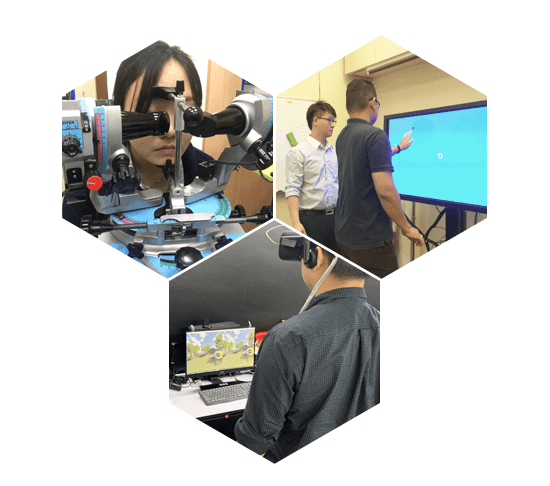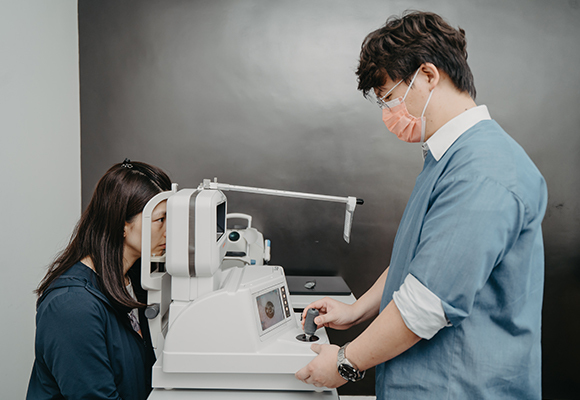Lazy Eye (Amblyopia, Mata Malas 懒惰眼)
Lazy eye, known as Amblyopia refers to a condition of the brain where it ignores visual information from one eye, and vision in that eye does not get better with any type of glasses, contact lenses, or surgery.
Lazy Eye (Amblyopia 懒惰眼) can be caused by an eye turn. The eye which is not looking where you want to look has to be ignored because the brain cannot make sense out of two different images.
It can also occur when one eye doesn’t see as clearly as the other eye and isn’t caught early enough. When this happens the eye becomes lazy, because it isn’t being used. Lazy Eye (Amblyopia, Mata Malas 懒惰眼) does not go away on its own. While many physicians were taught that it is not treatable past the age of 7 or 9 years of age, new research in the field of optometric vision therapy has shown otherwise. Depending on the reason, lazy eye therapy/training can be done no matter how old you are.
What is the difference between Lazy Eye and Eye Turn?
Lazy eye is a problem with visual acuity in one or both eyes that cannot be improved with glasses or contact lenses alone. The brain suppresses the information from either one or both eyes and doesn’t send the visual signal to the affected eye, make it eventually become weak. Eye turn, also called “Strabismus” is a problem in which both eyes do not focus on the same point at the same time. The patients do not necessarily require vision correction because they may have 20/20 normal visual acuity. They just suffer due to misaligned eye problems.
Why might you have Lazy Eye?
- Lazy Eye by Birth
The lazy eye has a tendency to associate with crossed eyes. It can happen during early childhood due to genetic from family. It is normal for a newborn's eyes to cross sometimes during the first few months. By that time, the eyes usually straighten out. Generally, develops up to age 6 years. On the other hand, a child might be more likely to have a lazy eye if they have developmental disabilities. This condition happens because the vision in the eyes might not develop the way it should.
- Lazy Eye by Accident
Lazy eyes can result from strokes, car accidents, concussions, etc. Research showed that 90% of traumatic brain injury (TBI) patients experience some visual problems due to the disruption of communication between the eyes and the brain. Injury to any part of visual pathways can affect the field of vision, the position of the eye, and how the eye moves.
Common Signs and Symptoms of Lazy Eye (Amblyopia)
Squints or closes one eye
Covers one eye while reading or looking at something close up
Inability to respond to some visual stimuli
Difficulty following moving objects
Bumps into objects while walking
Trouble with depth perception
Poor eye-hand coordination (poor handwriting, for example)
Uses finger to keep place when reading
Skips words when reading out loud
Moves head when reading
Complains of blurry vision or double images (diplopia)
Has trouble seeing 3D
How would Lazy Eye affect an adult
While their eyes may look straight, they often do not have full use of both of their eyes. And, they don’t work together to provide full 3D vision the way they should.
Reading, driving, sports performance, and even one’s ability to work can be affected by a lazy eye (Amblyopia, 懒惰眼). In today’s world being able to see 3D has become very important. Individuals with lazy eye cannot see the 3D effects in movies, etc.
Is it possible to fix the Lazy Eye for an adult?
Golden/Critical Period
While you may have been told that there is a golden/critical period where you can treat lazy, and that after this period it is no longer possible for lazy eye treatment - research has found that it is possible to help this condition no matter how old you are, even if you are an adult. Through Behavioral & developmental optometry we are able to help our patients learn how to use their eyes correctly at any age. In order to see if we can help you or your loved ones in treating lazy eye (Amblyopia, Mata malas, 懒惰眼), schedule a Neuro-functional vision evaluation with our Behavioral and Developmental optometrist.
Questions
Is It Too Late?
Many people think that vision therapy is only for children. However, adults have as much need for this type of vision care as children. Vision Therapy is often more effective for adults because they are usually more motivated to improve their visual abilities, whereas children may not understand that they have a problem or how that problem may affect their interests or future.
Plenty of people have visual problems sustaining near-centered work, including reading, writing, and computer use. When people have trouble using both eyes together or can't focus for great lengths of time, they do not simply grow out of these problems. Children with visual problems often become adults with visual problems.
Why Are Older Children, Teenagers and Adults with Lazy Eye Still Being Told That Nothing Can Be Done for Them? by neurobiologist Susan R. Barry, Ph.D. and Rachel Cooper
How Vision Problem Can Affect Your Life
Adults will figure out many ways to compensate for their visual problems so that they can continue with any strenuous visual work they need to do. Often, adults come home from work extremely tired when all they did was sit at a desk and do paperwork. Some people will feel as if they had just run a 10K race! Children, on the other hand, will tend to avoid tasks that are difficult or make them feel inadequate.
Available Lazy Eye Treatment for Adult in Malaysia
Understanding the different lazy eye treatment has the different efficiency to you. However, the important part is how to fix the lazy eye for you? There are 3 approaches to treat the lazy eye in Malaysia.
- Occlusion therapy using an eye patch
The “good” eye is covered up with a special patch for a few hours a day for several months, so the “lazy” eye is forced to work. However, using a patch to treat a lazy eye can be time-consuming and can often be an unpleasant experience for you until you get used it. This is because you are making your vision worse by taking your good eye away from you.
- Eye drops
Atropine eye drops can be used to temporarily make it difficult for the “good” eye to see properly. This drug dilates the pupil and numbs the muscles of the good eye making the lens unable to focus for a few hours, so the weaker eye is forced to work. However, the side effects that can occur for this treatment included eye irritation, redness of the eye and headaches.

At Sun Time Vision Specialists Centre, our specialized behavioral and developmental optometrist provide a very effective, non-surgical treatment that helps our patients eliminate lazy eye (Amblyopia, Mata Malas 懒惰眼).
We are able to teach our patients to use their two eyes together correctly which gets rid of the lazy eye. Just as there is physical therapy or speech therapy, there is Vision Therapy— therapy for the eyes. Our Behavioral and Developmental optometrist at Sun Time Vision Specialists Centre are certified to provide optometric Vision Therapy. We are able to teach children and adults how to use their two eyes correctly, and to treat a variety of vision problems which are not fully treatable with glasses, contact lenses or surgery.
Get a free consultation to correct your Lazy Eye
A Neuro-Developmental & Behavioral optometrist can help to reduce the strain of near work as well as work with any other kinds of visual problems. The proper lenses along with vision therapy could make a tremendous difference in an adult's ability to function at work or sports, just as with children of school age.
We understand that you might have a number of questions; especially if this is the first time you are hearing that you may have a vision problem. Please feel free to call our office with your questions. Phone 03- 2110 3967 or Whatsapp us.
The first step to treat lazy eye (Amblyopia, Mata Malas 懒惰眼) is to schedule a Neuro-Developmental & functional vision evaluation to determine to what degree the vision problem is contributing to your difficulties. Once the testing is completed our Behavioral and Developmental optometrist will meet with you in a separate appointment to review the results and go over the recommended program to treat amblyopia.


